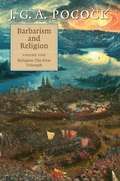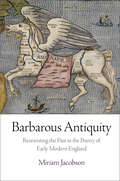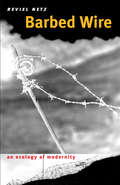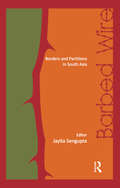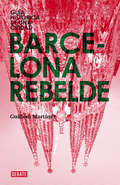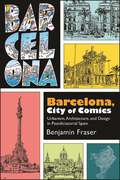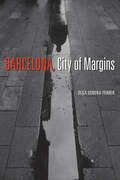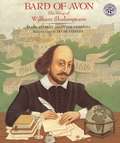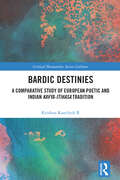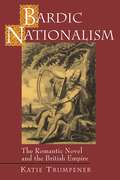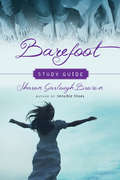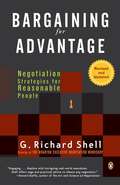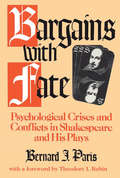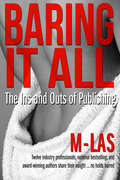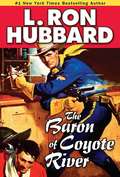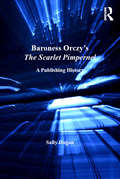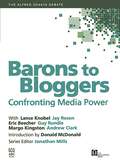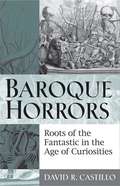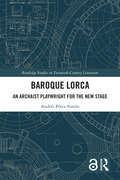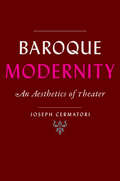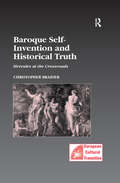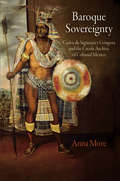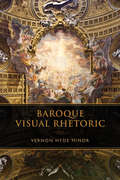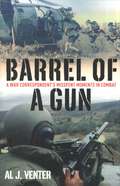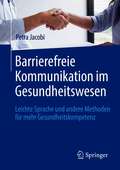- Table View
- List View
Barbarism and Religion: The First Triumph
by J. G. A. PocockThis fifth volume in John Pocock's acclaimed sequence on Barbarism and Religion turns to the controversy caused by Edward Gibbon's treatment of the early Christian church. Examining this controversy in unprecedented depth, Pocock challenges the assumption that Gibbon wrote with the intention of destroying belief in the Christian revelation, and questions our understanding of the character of 'enlightenment'. Reconsidering the genesis, inception and reception of these crucial chapters of Decline and Fall, Pocock explores the response of Gibbon's critics, affirming that his reputation as an unbeliever was established before his history of the Church had been written. The magnitude of Barbarism and Religion is already apparent. Religion: The First Triumph will be read not just as a remarkable analysis of the making of Decline and Fall, but also as a comment on the collision of belief and disbelief, a subject as pertinent now as it was to Gibbon's eighteenth-century readers.
Barbarous Antiquity
by Miriam JacobsonIn the late sixteenth century, English merchants and diplomats ventured into the eastern Mediterranean to trade directly with the Turks, the keepers of an important emerging empire in the Western Hemisphere, and these initial exchanges had a profound effect on English literature. While the theater investigated representations of religious and ethnic identity in its portrayals of Turks and Muslims, poetry, Miriam Jacobson argues, explored East-West exchanges primarily through language and the material text. Just as English markets were flooded with exotic goods, so was the English language awash in freshly imported words describing items such as sugar, jewels, plants, spices, paints, and dyes, as well as technological advancements such as the use of Arabic numerals in arithmetic and the concept of zero. Even as these Eastern words and imports found their way into English poetry, poets wrestled with paying homage to classical authors and styles. In Barbarous Antiquity, Jacobson reveals how poems adapted from Latin or Greek sources and set in the ancient classical world were now reoriented to reflect a contemporary, mercantile Ottoman landscape. As Renaissance English writers including Shakespeare, Jonson, Marlowe, and Chapman weighed their reliance on classical poetic models against contemporary cultural exchanges, a new form of poetry developed, positioned at the crossroads of East and West, ancient and modern. Building each chapter around the intersection of an Eastern import and a classical model, Jacobson shows how Renaissance English poetry not only reconstructed the classical past but offered a critique of that very enterprise with a new set of words and metaphors imported from the East.
Barbed Wire: An Ecology of Modernity
by Reviel NetzThe history of animals and humans as seen through barbed wire. In this original and controversial book, historian and philosopher Reviel Netz explores the development of a controlling and pain-inducing technology—barbed wire. Surveying its development from 1874 to 1954, Netz describes its use to control cattle during the colonization of the American West and to control people in Nazi concentration camps and the Russian Gulag. Physical control over space was no longer symbolic after 1874. This is a history told from the perspective of its victims. With vivid examples of the interconnectedness of humans, animals, and the environment, this dramatic account of barbed wire presents modern history through the lens of motion being prevented. Drawing together the history of humans and animals, Netz delivers a compelling new perspective on the issues of colonialism, capitalism, warfare, globalization, violence, and suffering. Theoretically sophisticated but written with a broad readership in mind, Barbed Wire calls for nothing less than a reconsideration of modernity.
Barbed Wire: Borders and Partitions in South Asia
by Jayita SenguptaThe book is an anthology of creative and critical responses to the many partitions of India within and across borders. By widening and reframing the question of partition in the subcontinent from one event in 1947 to a larger series of partitions, the book presents a deeper perspective both on the concept of partition in understanding South Asia, and understanding the implications from survivors, victims and others. The imagery of the barbed wire in the title is used precisely to confront the jaggedness of experiencing and surviving partition that still haunts the national, literary, religious and political matrices of India. The volume is a compilation of short stories, poems, articles, news reports and memoirs, with each contributor bringing forth their perception of partition and its effects on their life and identity. The many narratives amplify the human cost of partitions, examining the complexities of a bruised nation at the social, psychological and religious levels of consciousness. The book will appeal to anyone interested in literary studies, history, politics, sociology, cultural studies, and comparative literature.
Barcelona rebelde: Guía histórica de una ciudad
by Guillem MartínezUn recorrido por los lugares emblemáticos de la Barcelona más revolucionaria. Engels dijo que Barcelona es la ciudad del mundo que más levantamientos ha producido. Lo que equivale a decir que también es la ciudad que más aplastamientos ha sufrido. Y lo malo de las cosas aplastadas es que son difíciles de observar a través de lo que tienen encima. Barcelona rebelde intenta ver la Barcelona que hay debajo de Barcelona, y que aún subsiste, si uno se fija, entre sus calles. Es una Barcelona con una historia diferente a la que se le presupone, con encontronazos con España y con Cataluña. Una Barcelona que empezó a liarla muy pronto y que irá chocando con la autoridad del rey de Aragón primero, y con la de los sucesivos reyes de España después. Proclamó la república en el siglo XVII, con un par, y padeció en el siglo XVIII lo que fue la primera guerra civil con el canon español de guerra civil (asesinatos, exilio, represalias). En el XIX se enfrentó a la explotación y al Estado, y asistió a ejercicios de represión difíciles de imaginar cuando se pasea por Barcelona un día de sol y pajaritos. En el siglo XX ha vivido dos revoluciones libertarias, los primeros bombardeos sobre población civil, la dictadura fascista más longeva de Europa y la represión más dilatada. Y, paralelamente, a lo largo de los siglos y en esas mismas calles, Barcelona ha generado también una forma de vida privada propia, extraña en la Península, que maravilló a tipos como Cervantes, Moratín o Genet, y con la que sus ciudadanos, esos con los que te cruzas en esas esas calles de Barcelona, formulan su rebeldía íntima.
Barcelona, City of Comics: Urbanism, Architecture, and Design in Postdictatorial Spain (SUNY series in Latin American and Iberian Thought and Culture)
by Benjamin FraserBarcelona, City of Comics introduces readers of English to a range of Spanish- and Catalan-language comics published after the death of dictator Francisco Franco in 1975. During this time of palpable social change, the Catalonian capital regained its reputation as the hub of comics publishing in Spain. Comics collectives such as El Rrollo and Butifarra, as well as individual artists from Montse Clavé to Mariscal, contributed to a thriving comics subculture that drew from and pushed beyond the countercultural comics tradition in the United States. As the Salón Internacional del Cómic de Barcelona (1981–) drew greater attention to the city, comics magazines teemed with graphic depictions of urban scenes. On the comics page, themes of architecture and city life were employed as social critique, while the city of Barcelona itself increasingly solidified its reputation on the global stage through urban planning. With a foreword by Pere Joan, Barcelona, City of Comics delves into the relationship between comics and urbanism in one of Europe's most notable global cities.
Barcelona, City of Margins (Toronto Iberic)
by Olga Sendra FerrerBarcelona, City of Margins studies the creation of a space of dissent in the 1950s and 1960s that became the pillar of the protest movements during the final years of the Franco dictatorship and the transition to democracy. This space of dissent took shape in the margins of what is considered the official space of the city of Barcelona, revealing the interconnection of urbanism, literature, and photography in the formation of the political, social, and cultural movements to come in the 1970s. Olga Sendra Ferrer draws from theoretical readings on built environments, neighbourhoods, housing projects and developments, and everyday life within Spanish urban spaces. Literature and photography demonstrate the political value of cultural production and forms of cultural representation that occur from peripheral zones – those pushed aside by exclusionary politics, fascist forms of control, surveillance, and homogenization. In search of the origins of the protest movements and counter culture that would come in the final years of the Franco regime, Barcelona, City of Margins asserts the value of urban movement and cultural practice as a challenge to the spatial and urbanistic regime of Francoism.
Bard of Avon: The Story of William Shakespeare
by Diane Stanley Vennema Peter VennemaA brief biography of the world's most famous playwright, using only historically correct information.
Bardic Destinies: A Comparative Study of European Poetic and Indian Kavya-Itihasa Tradition (Critical Humanities Across Cultures)
by Krishna R. KanchithThis volume critically explores the cultural significance and fate of the “literary” in the European and the Indian traditions as it traces the history of the reception of works that have had a deep hold on the lives and sensibilities of people across time and cultures. The book grapples with three major concepts in the humanities—the literary, the philosophical/theological and the historical. It looks at Homer’s reception by Plato; Virgil’s reception by Christianity; the many responses that The Mahabharata has received over centuries and across cultures in India; and the reception of Kumaravyasa’s Kumaravyasabharata, among other works, and analyses the understanding of truth, time and history that influence the reading of these works in different times and cultural contexts. Part of the Critical Humanities across Cultures series, this book will be useful for scholars and researchers of philosophy, literature, history, comparative literature, cultural studies and post-colonial studies.
Bardic Nationalism: The Romantic Novel and the British Empire (Literature in History #2)
by Katie TrumpenerThis magisterial work links the literary and intellectual history of England, Scotland, Ireland, and Britain's overseas colonies during the late eighteenth and early nineteenth centuries to redraw our picture of the origins of cultural nationalism, the lineages of the novel, and the literary history of the English-speaking world. Katie Trumpener recovers and recontextualizes a vast body of fiction to describe the history of the novel during a period of formal experimentation and political engagement, between its eighteenth-century "rise" and its Victorian "heyday." During the late eighteenth century, antiquaries in Ireland, Scotland, and Wales answered modernization and anglicization initiatives with nationalist arguments for cultural preservation. Responding in particular to Enlightenment dismissals of Gaelic oral traditions, they reconceived national and literary history under the sign of the bard. Their pathbreaking models of national and literary history, their new way of reading national landscapes, and their debates about tradition and cultural transmission shaped a succession of new novelistic genres, from Gothic and sentimental fiction to the national tale and the historical novel. In Ireland and Scotland, these genres were used to mount nationalist arguments for cultural specificity and against "internal colonization." Yet once exported throughout the nascent British empire, they also formed the basis of the first colonial fiction of Canada, Australia, and British India, used not only to attack imperialism but to justify the imperial project. Literary forms intended to shore up national memory paradoxically become the means of buttressing imperial ideology and enforcing imperial amnesia.
Barefoot Study Guide (Sensible Shoes Series)
by Sharon Garlough BrownThe journeys of Hannah, Meg, Charissa, and Mara take unexpected turns in Barefoot, the third book of the Sensible Shoes series. In this study guide author Sharon Garlough Brown has crafted a practical resource to help you process the characters' stories and explore the novel's spiritual formation themes more deeply. You'll find twelve weeks of daily Scripture readings, reflection questions, and invitations to prayer, with weekly discussion questions and practices for groups to do together. Each week also features a list of spiritual disciplines used by the characters that you can incorporate into your own life with God. Individually or with a group, as you walk with the women of Sensible Shoes on holy ground, you'll be invited to encounter God in significant new ways.
Bargaining for Advantage: Negotiation Strategies for Reasonable People
by G. Richard ShellThe award-winning guide to business negotiation used by top negotiators and training programs all over the world-- completely updated and revised. As director of the renowned Wharton Executive Negotiation Workshop, Professor G. Richard Shell has taught thousands of business leaders, administrators, and other professionals how to survive and thrive in the sometimes rough-and-tumble world of negotiation. His systematic, step- by-step approach comes to life in this book, which is available in over ten foreign editions and combines lively story telling, proven tactics, and reliable insights gleaned from the latest negotiation research. This updated edition includes: A brand-new "Negotiation I.Q." test designed by Shell and used by executives at the Wharton workshop that reveals each reader's unique strengths and weaknesses as a negotiator. A concise manual on how to avoid the perils and pitfalls of online negotiations involving e-mail and instant messaging. A detailed look at how gender and cultural differences can derail negotiations, and advice for putting talks back on track.
Bargains with Fate: Psychological Crises and Conflicts in Shakespeare and His Plays
by Maria JaroszThe enduring appeal of Shakespeare's works derives largely from the fact that they contain brilliantly drawn characters. Interpretations of these characters are products of changing modes of thought, and thus past explanations of their behavior, including Shakespeare's, no longer satisfy us. In this work, Bernard J. Paris, an eminent Shakespearean scholar, shows how Shakespeare endowed his tragic heroes with enduring human qualities that have made them relevant to people of later eras.Bargains with Fate employs a psychoanalytic approach inspired by the theories of Karen Horney to analyze Shakespeare's four major tragedies and the personality that can be inferred from all of his works. This compelling study first examines the tragedies as dramas about individuals with conflicts like our own who are in a state of crisis due to the breakdown of their bargains with fate, a belief that they can magically control their destinies by living up to the dictates of their defensive strategies.Filled with bold hypotheses supported by carefully detailed accounts, this innovative study is a resource for students and scholars of Shakespeare, and for those interested in literature as a source of psychological insight. The author's combination of literary and psychoanalytic perspectives guides us to a humane understanding of Shakespeare and his protagonists, and, in turn, to a more profound knowledge of ourselves and human behavior.
Baring it All: The Ins and Outs of Publishing
by Renee Bernard Naleighna Kai J. L. Woodson Martha Kennerson D. J. Mclaurin Joyce A. Brown Susan D. Peters Valarie Prince L. A. Lewis Tanishia Pearson-Jones Candy Jackson Janice PernellThis is the one book most authors wished they had before they took a bite of the publishing apple. USA Today Bestselling author, Renee Bernard ; National Bestselling author, Naleighna Kai ; Award-winning authors J. L. Woodson , Martha Kennerson , Susan D. Peters , L. A. Lewis , and Janice Pernell ; along with D. J. McLaurin , Joyce A. Brown , Valarie Prince , Candy Jackson , and Tanishia Pearson-Jones share their insight, wisdom, and their publishing journeys--from self-publishing to signing with independent publishing houses to landing deals with the major houses and achieving nationwide success. Though each author took a different road, what they all have in common is the desire to share their experiences so that aspiring writers can make informed decisions about the best path to take and learn from the mistakes they made along the way. If this book does not inspire you to get off your butt and write ... nothing will.
Baron of Coyote River, The
by L. Ron HubbardExperience the Old West. Lance Gordon killed his father's murderer in a fair fight, but now he's got a price on his head and has been running from the law ever since. Cornered by men of the US Cavalry in Santos, Lance gets rescued by a mystery man who convinces him to join forces and go after a notorious cattle rustler up the infamous Coyote River. Even together the pair stands barely a chance of bringing the gang of thieves to account, much less dealing with the soldiers still hot on their trail. ALSO INCLUDES THE WESTERN STORY "REIGN OF THE GILA MONSTER""Heart-racing plot charges at the speed of thrumming hooves."--Library Journal* An International Book Awards Finalist
Baroness Orczy's The Scarlet Pimpernel: A Publishing History (Ashgate Studies In Publishing History: Manuscript, Print, Digital Ser.)
by Sally DuganSince its publication in 1905, The Scarlet Pimpernel has experienced global success, not only as a novel but in theatrical and film adaptations. Sally Dugan charts the history of Baroness Orczy's elusive hero, from the novel's origins through its continuing afterlife, including postmodern appropriations of the myth. Drawing on archival research in Britain, the United States and Australia, her study shows for the first time how Orczy's nationalistic superhero was originally conceived as an anarchist Pole plotting against Tsarist Russia, rather than a counter-revolutionary Englishman. Dugan explores the unique blend of anarchy, myth and magic that emerged from the story's astonishing and complex beginnings and analyses the enduring elements of the legend. To his creator, the Pimpernel was not simply a swashbuckling hero but an English gentleman spreading English values among benighted savages. Dugan investigates the mystery of why this imperialist crusader has not only survived the decline of the meta-narratives surrounding his birth, but also continues to enthrall a multinational audience. Offering readers insights into the Pimpernel's appearances in print, in film and on the stage, Dugan provides a nuanced picture of the trope of the Scarlet Pimpernel and an explanation of the phenomenon's durability.
Barons To Bloggers: Confronting Media Power
by Mills, JonathanWhatever one thinks of Rupert Murdoch or his ethics, when a mogul of his stature stands on a public platform and predicts the end of God-like media figures telling people what's important, you begin to realise that there's something seismic going on in the world of communications. Seismic, but unpredictable. -Eric Beecher, Publisher, crikey.com Media power is undergoing a massive transformation. Is the Internet undermining the authority of traditional news institutions? And will it fulfil our expectations of greater democracy? In a provocative and incisive debate, Barons to Bloggers brings together prominent international and Australian media commentators to examine what is shaping up to become the radical upheaval of the old hierarchies of news and opinion. Contributors: Lance Knobel, former Program Director, World Economic Forum Jay Rosen, Associate Professor of Journalism, New York University Donald McDonald, Chairman, Australian Broadcasting Corporation Eric Beecher, Publisher, crikey.com Guy Rundle, writer and Executive Producer, ABC TV Margo Kingston, political commentator and Editor, SMH's Webdiary Andrew Clark, Australian Financial Review journalist, former Editor, Sun-Herald
Baroque Horrors: Roots of the Fantastic in the Age of Curiosities
by David R. Castillo"Baroque Horrors is a textual archeologist's dream, scavenged from obscure chronicles, manuals, minor histories, and lesser-known works of major artists. Castillo finds tales of mutilation, mutation, monstrosity, murder, and mayhem, and delivers them to us with an inimitable flair for the sensational that nonetheless rejects sensationalism because it remains so grounded in historical fact." ---William Egginton, Johns Hopkins University. Baroque Horrors turns the current cultural and political conversation from the familiar narrative patterns and self-justifying allegories of abjection to a dialogue on the history of our modern fears and their monstrous offspring. When life and death are severed from nature and history, "reality" and "authenticity" may be experienced as spectator sports and staged attractions, as in the "real lives" captured by reality TV and the "authentic cadavers" displayed around the world in the Body Worlds exhibitions. Rather than thinking of virtual reality and staged authenticity as recent developments of the postmodern age, Castillo looks back to the Spanish baroque period in search for the roots of the commodification of nature and the horror vacui that accompanies it. Aimed at specialists, students, and readers of early modern literature and culture in the Spanish and Anglophone traditions as well as anyone interested in horror fantasy, Baroque Horrors offers ways to rethink broad questions of intellectual and political history and relate them to the modern age. David Castillo is Associate Professor and Director of Graduate Studies in the Department of Romance Languages and Literatures at the University at Buffalo, SUNY.
Baroque Lorca: An Archaist Playwright for the New Stage (Routledge Studies in Twentieth-Century Literature)
by Andrés Pérez-SimónBaroque Lorca: An Arcaist Playwright for the New Stage defines Federico García Lorca’s trajectory in the theater as a lifelong search for an audience. It studies a wide range of dramatic writings that Lorca created for the theater, in direct response to the conditions of his contemporary industry, and situates the theory and praxis of his theatrical reform in dialogue with other modernist renovators of the stage. This book makes special emphasis on how Lorca engaged with the tradition of Spanish Baroque, in particular with Cervantes and Calderón, to break away from the conventions of the illusionist stage. The five chapters of the book analyze Lorca’s different attempts to change the dynamics of the Spanish stage from 1920 to his assassination in 1936: His initial incursions in the arenas of symbolist and historical drama (The Butterfly’s Evil Spell, Mariana Pineda); his interest in puppetry (The Billy-Club Puppets and In the Frame of Don Cristóbal) and the two ‘human’ farces The Shoemaker’s Prodigious Wife and The Love of Don Perlimplín and Belisa in the Garden; the central piece in his project of ‘impossible’ theater (The Public); his most explicitly political play, one that takes the violence to the spectators’ seats (The Dream of Life); and his three plays adopting, an altering, the contemporary formula of ‘rural drama’ (Blood Wedding, Yerma and The House of Bernarda Alba).
Baroque Modernity: An Aesthetics of Theater (Hopkins Studies in Modernism)
by Joseph CermatoriA groundbreaking study on the vital role of baroque theater in shaping modernist philosophy, literature, and performance.Winner, Helen Tartar First Book Subvention AwardBaroque style—with its emphasis on ostentation, adornment, and spectacle—might seem incompatible with the dominant forms of art since the Industrial Revolution, but between 1875 and 1935, European and American modernists connected to the theater became fascinated with it. In Baroque Modernity, Joseph Cermatori argues that the memory of seventeenth-century baroque stages helped produce new forms of theater, space, and experience around the turn of the twentieth century. In response, modern theater helped give rise to the development of the baroque as a modern philosophical idea. The book focuses on avant-gardists whose writing takes place between theory and performance: philosophical theater-makers and theatrical philosophers including Friedrich Nietzsche, Stéphane Mallarmé, Walter Benjamin, and Gertrude Stein. Moving between page and stage, this study tracks the remnants of seventeenth-century theater through modernist aesthetics across an array of otherwise disparate materials, including modern opera, Bertolt Brecht's Epic Theater, poetic tragedies, and miracle plays. By reexamining the twentieth century's engagements with Gianlorenzo Bernini, William Shakespeare, Claudio Monteverdi, Calderón de la Barca, and other seventeenth-century predecessors, the book delineates an enduring tradition of baroque performance. Along the way, Cermatori expands our familiar narratives of "the modern" and traces a history of theatricality that reverberates into the twenty-first century. Baroque Modernity will appeal to readers in a wide array of disciplines, including comparative literature, theater and performance, art and music history, intellectual history, and aesthetic theory.
Baroque Self-Invention and Historical Truth: Hercules at the Crossroads (Studies in European Cultural Transition #23)
by Christopher BraiderIn his monumental study, Christopher Braider explores the dialectical contest between history and truth that defines the period of cultural transition called the 'baroque'. For example, Annibale Carracci's portrayal of the Stoic legend of Hercules at the Crossroads departs from earlier, more static representations that depict an emblematic demigod who has already rejected the fallen path of worldly Pleasure for the upward road of heroic Virtue. Braider argues that, in breaking with tradition in order to portray a tragic soliloquist whose dominant trait is agonized indecision, Carracci joins other baroque artists, poets and philosophers in rehearsing the historical dilemma of choice itself. Carracci's picture thus becomes a framing device that illuminates phenomena as diverse as the construction of gender in baroque painting and science, the Pauline ontology of art in Caravaggio and Rembrandt, the metaphysics of baroque soliloquy and the dismantling of Cartesian dualism in Cyrano de Bergerac and Pascal.
Baroque Sovereignty: Carlos de Siguenza y Gongora and the Creole Archive of Colonial Mexico
by Anna MoreIn the seventeenth century, even as the Spanish Habsburg monarchy entered its irreversible decline, the capital of its most important overseas territory was flourishing. Nexus of both Atlantic and Pacific trade routes and home to an ethnically diverse population, Mexico City produced a distinctive Baroque culture that combined local and European influences. In this context, the American-born descendants of European immigrants—or creoles, as they called themselves—began to envision a new society beyond the terms of Spanish imperialism, and the writings of the Mexican polymath Carlos de Sigüenza y Góngora (1645-1700) were instrumental in this process. Mathematician, antiquarian, poet, and secular priest, Sigüenza authored works on such topics as the 1680 comet, the defense of New Spain, pre-Columbian history, and the massive 1692 Mexico City riot. He wrote all of these, in his words, "out of love for my patria."Through readings of Sigüenza y Góngora's diverse works, Baroque Sovereignty locates the colonial Baroque at the crossroads of a conflicted Spanish imperial rule and the political imaginary of an emergent local elite. Arguing that Spanish imperialism was founded on an ideal of Christian conversion no longer applicable at the end of the seventeenth century, More discovers in Sigüenza y Góngora's works an alternative basis for local governance. The creole archive, understood as both the collection of local artifacts and their interpretation, solved the intractable problem of Spanish imperial sovereignty by establishing a material genealogy and authority for New Spain's creole elite. In an analysis that contributes substantially to early modern colonial studies and theories of memory and knowledge, More posits the centrality of the creole archive for understanding how a local political imaginary emerged from the ruins of Spanish imperialism.
Baroque Visual Rhetoric
by Vernon Hyde MinorIntricate, expressive, given to grandeur and even excess, Baroque art as a style is inseparable from the meanings it seeks to convey. Vernon Hyde Minor's Baroque Visual Rhetoric probes this combination of style and message and - equally importantly - the methodological basis on which the critical art historian comes to establish that meaning.Drawing on a breathtaking range of critical literature, from the German founders of art history as an academic discipline to Heidegger, Derrida, and de Man, Minor considers the issue through a series of Baroque masterpieces: Bernini's Baldacchino in St. Peter's Basilica, the statues in the church of San Giovanni in Laterano, Borromini's church of Sant'Ivo alla Sapienza, Baciccio's frescoes in the church of Il Gesù, the paintings of Philippe de Champaigne, and the Corsini Chapel in San Giovanni in Laterano.
Barrel of a Gun: A War Correspondent’s Misspent Moments in Combat
by Al Venter<p>“Anybody who says that the pen is mightier than the sword hasn’t spent time in Somalia, or in Beirut during its bloody heyday.” So begins this fascinating memoir of a journalist, filmmaker, and just plain raconteur who has made a career of examining warfare—on the ground and as the bullets are flying. While the average citizen is aware of violent conflicts broiling all around the globe, Al J. Venter—from some strange compulsion unexplainable even by him—has felt the need to see them all in person, preferably at the center of the action. <p>Born in South Africa, Venter has found no shortage of horrific battles on his own continent, from Rhodesia to Biafra, and Angola to Somalia. He has ridden with the legendary merc group Executive Outcomes, jumped into combat with South Africa’s crack Parachute Regiment (the Parabats), and traipsed the jungles with both guerrillas and national troops under whichever strongman in the country then held power. During Sierra Leone’s civil war he flew in the government’s lone Mi-24 Hind gunship as it blasted apart rebel villages and convoys, his complaint being that the Soviet-made craft leaked when it rained. <p>In the Mideast he went into southern Lebanon with the invading Israeli army as it encountered resistance from multiple Muslim groups, including the newly formed Hezbollah. Curious about the other side of the hill, he joined up with General Aoun’s Christian militias while that conflict was at its height. Touching down in Croatia during the Balkan wars, and in Congo during their perpetual one, as well as the Uganda of Idi Amin, Venter never lost his lust for action, even as he sometimes had to put down his camera or notebook to pick up an AK-47.</p>
Barrierefreie Kommunikation im Gesundheitswesen: Leichte Sprache und andere Methoden für mehr Gesundheitskompetenz
by Petra JacobiDas Buch stellt die Möglichkeiten vor, allen Menschen den Zugang zu Kommunikation und Information im medizinischen Kontext ohne fremde Hilfe zugänglich zu machen. Die Autorin stellt die Grundlagen und Maßnahmen Barrierefreier Kommunikation wie Leichte Sprache, Unterstützte Kommunikation oder Digitale Barrierefreiheit vor und gibt Fachkräften im Gesundheitsbereich Tipps zur Anwendung. Sie lernen, wie Sie medizinische Sachverhalte leicht verständlich, zielgruppengerecht und patientenzentriert vermitteln, um Compliance und Adhärenz zu fördern.
